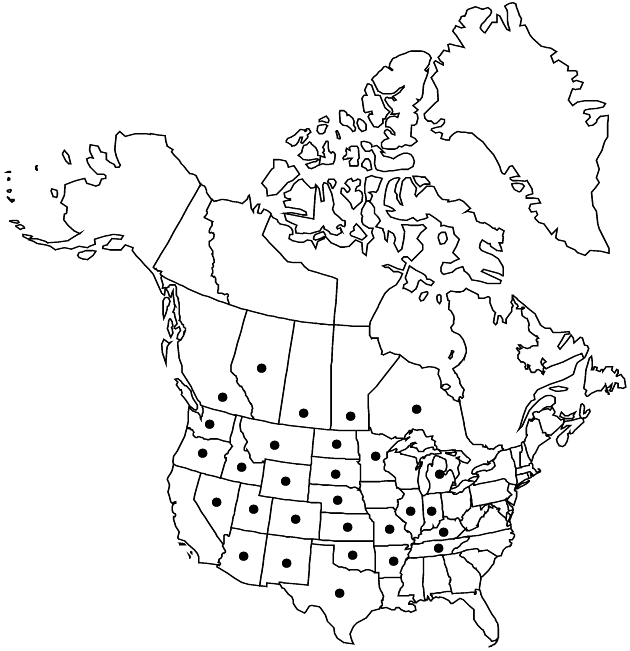Solidago missouriensis
J. Acad. Nat. Sci. Philadelphia 7: 32. 1834.
Plants (10–) 30–80 cm; rhizomes short to long. Stems 1–50+, erect, glabrous or sometimes sparsely strigose in arrays; fascicles of small lateral branch leaves often present in axils. Leaves: proximal cauline tapering to long, winged petioles, blades oblanceolate to linear-oblanceolate, 50–100 (–200) (including petiole) × (5–) 10–20 (–30) mm, margins entire to serrulate, usually 3-nerved (2 larger lateral nerves), apices acute, mucronate to acuminate and somewhat spinulose, glabrous; mid to distal cauline sessile, blades lanceolate to linear, 40–60 × (2–) 4–14 mm, rapidly reduced distally, margins entire, ciliate, faces glabrous. Heads 10–210 in paniculiform arrays, broadly secund-pyramidal or more rhombic to transversely rhombic, (1.5–) 3–12 (–20) × (1.5–) 3–12 cm; branches glabrous with secund heads spreading and arching, sometimes ascending with non-secund heads. Peduncles 1.4–5 mm, glabrous or sparsely strigose; bracteoles 0–3+, linear to lanceolate. Involucres narrowly to broadly campanulate, 2.5–4.5 mm. Phyllaries in 3–4 series, strongly unequal, margins ciliate-fimbriate, especially apically; outer ovate to lanceolate, acute to rounded, inner linear-ovate to oblong or linear-lanceolate, obtuse to rounded. Ray-florets 5–14; laminae 1.5–2 (–4) × 0.2–0.5 (–0.75) mm. Disc-florets (6–) 8–20; corollas (2–) 3–4 mm, lobes 0.4–1 mm. Cypselae (obconic) 1–2 mm, glabrous or sparsely strigose; pappi 2.5–3 mm. 2n = 18, 36.
Phenology: Flowering (Jul–)Aug–Oct.
Habitat: Open sandy and rocky soils, clay soils, prairies, grasslands, pastures, open conifers forests in foothills and proximal elevations of mountains, sandstone ledges, limestone glades, disturbed soils, roadsides
Elevation: 200–2200+ m
Distribution

Alta., B.C., Man., Ont., Sask., Ariz., Ark., Colo., Idaho, Ill., Ind., Kans., Ky., Mich., Minn., Mo., Mont., Nebr., Nev., N.Mex., N.Dak., Okla., Oreg., S.Dak., Tenn., Tex., Utah, Wash., Wyo., Mexico (Coahuila)
Discussion
Solidago missouriensis was often introduced along railroad lines farther east. It is a highly variable species. In the east, it can be similar to S. juncea and is not always easily distinguished where ranges overlap. In the west, it can similar to smaller plants of S. spectabilis. It is distinguished from the related species by its usually 3-nerved proximal leaves and the usually thin, elongate rhizomes. Across the prairies the species is known to be diploid only (2n = 18). In the Rocky Mountains, tetraploids (2n = 36) are common, the diploids infrequent.
A number of varieties have been described. Shorter, often larger-headed plants (tetraploids when known) from the Rocky Mountains have been treated as var. missouriensis (including var. extraria). Taller, more leafy-stemmed plants, mostly from the eastern half of the range, but occasionally west to Washington, have been treated as var. fasciculata. Plants from Arizona, Colorado, and New Mexico with long, linear leaves have been treated as var. tenuissima. Larger-headed plants with narrow bracts from prairies west of the Cascades in Oregon and Washington have been treated as var. tolmieana. A. Cronquist (1994) opted not to recognize varieties, noting that all appeared to grade continuously into each other. A detailed study of the species is needed.
Selected References
None.